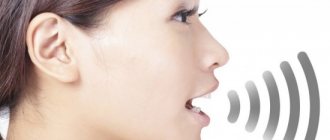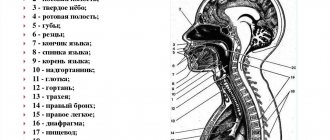Igor Esipov “Quantum” No. 12, 2018
Acoustics is a branch of physics that studies the excitation, propagation, reception of sound waves, as well as their interaction with the environment. A feature of sound waves that distinguishes them from electromagnetic or gravitational waves is that they can propagate only in a continuous elastic medium. Sound surrounds us everywhere: in the atmosphere, under water, underground, in biological environments and materials, and even in space. Only sound can propagate through terrestrial structures and under water without significant attenuation, so it is widely used in the study of natural environments.
Usually we call what we hear sound. It is generally accepted that the frequency range of the sound we hear lies in the range from 20 Hz to 20 kHz. This corresponds to 20–20,000 vibrations per second. Sound waves whose oscillation frequency exceeds this range have received their own special names.
Ultrasound
are called sound waves whose oscillation frequency is above 20 kHz.
The technologically advanced range of ultrasound applications ranges from 20 kHz to 100 MHz. The higher frequency region of ultrasound is called hypersound
. Sound waves of hypersonic frequencies can propagate only in crystals with low sound absorption, such as single crystals of quartz, sapphire, lithium niobate, yttrium iron garnet, etc. Hypersound is used in processing large amounts of information, including optical images, and studying the structure of solids tel. This is the science of acoustoelectronics. The range in which hypersound is excited in an artificial, controlled manner is limited to frequencies of the order of 10 GHz, which is associated with high attenuation. At such high frequencies, the wavelength of such sound will be comparable to the interatomic distance in the crystal. In this case, we can no longer consider the crystal to be a continuous medium.
Sound waves whose frequency is below 20 Hz are called infrasound
. The attenuation of infrasound is low, and therefore infrasound waves are actively used to study the ocean and the structure of the earth. The sounds of volcanic explosions can circle the entire globe, and low-frequency underwater sound travels thousands of kilometers across oceans.
Next, we will discuss modern ideas and new acoustic technologies for studying and mastering the surrounding world. Often acoustic methods have no alternative and therefore turn out to be the most effective for solving a particular important problem.
Structure of the hearing organ
Sounds surround a person from birth. There are 3 sections of the hearing organ:
- outer ear;
- middle ear;
- inner ear.
The outer ear is the visible part of the organ. It is represented by the auricle and the external auditory canal. The concha is a funnel-shaped cartilage covered with skin. On its surface there are various formations: pits, curls, hills. They help improve sound quality, make it louder and direct it into the ear canal.
The fibers of the ear muscles are attached to the concha. In the process of evolution, man has lost the ability to “move his ears” in order to more accurately localize sounds; these muscles work in rare “lucky” people. The skin of the shell has sebaceous and sweat glands.
The external auditory canal is a winding canal, the length of which is slightly more than 2 cm, and the diameter is up to 0.7 cm. In it, the sound signal continues to be amplified and transmitted to the middle ear. The passage is lined with skin containing sebaceous and sulfur glands. Earwax is a yellowish substance that provides hydration to the canal and protection against infectious agents. When accumulated and compacted, it forms plugs that disrupt the movement of the eardrum. This can lead to conductive hearing loss.
Describing the structure of the hearing organ, anatomists indicate that the outer part of the canal has cartilaginous walls, and the part in contact with the middle ear has bone walls. The structures of the middle and inner ear are located in the body of the temporal bone.
The eardrum is a thin membrane covered on the outside with skin and on the inside with mucous membrane. In young children, it has an opening that exposes the middle ear to the outside environment and is more vulnerable to infection. It closes by 3 years.
The middle ear is a cavity whose volume is slightly more than 1 cubic centimeter. It contains three small auditory ossicles, which are connected to each other in a chain:
- hammer;
- anvil;
- stapes.
They are named so because of their resemblance to everyday objects. The stapes connects to the window of the vestibule. The middle ear is also connected to the nasopharynx via the Eustachian tube.
The inner ear is the most bizarre formation of the human hearing organ. It consists of:
- vestibule (vestibulum);
- snails;
- semicircular canals.
The organ of hearing includes only the cochlea. It contains lymphatic fluid and stretches fibers (the main membrane). Each of the fibers is like a small string and “responds” (resonates) to a sound of a certain frequency. There are about 25 thousand of these fibers. On the wall of the cochlear canal there is a receptor field, which consists of nerve (hair) cells - the organ of Corti. The death of hair cells can lead to sensorineural hearing loss.
How are sounds formed? Consultation on speech therapy on the topic
ARTICULATORY GYMNASTICS COMPLEX
TO FORM THE CORRECT PRONUNCIATION OF THE SOUNDS [Р], [Р,]
Tongue exercises:
“SWING”: smile, open your mouth. On the count of 1-2, alternately rest your tongue on the upper and lower teeth. The lower jaw is motionless.
“TASTY JAM”: mouth open. Using a wide tongue, lick your upper lip and move your tongue deep into your mouth.
“MAYAR”: smile, open your mouth. Using the wide tip of your tongue, stroke the palate from the teeth to the throat and back. The lower jaw should not move.
“CLEAN YOUR UPPER TEETH”: smile, open your mouth slightly. Using the tip of a wide tongue, “clean” the upper teeth from the inside, moving the tongue left and right.
“HORSE”: smile, open your mouth. Click the tip of your tongue like a horse clicking. The mouth should be open, the tongue should be wide, and the lower jaw should be motionless.
“MUSHROOM”: smile, open your mouth. Suck your wide tongue to the roof of your mouth. This is the mushroom cap, and the hyoid ligament is the stalk. The tip of the tongue should not turn up, the lips should be in a smile.
“Accordion”: tongue position as in the “Mushroom” exercise, lips in a smile. Without lifting your tongue from the palate, open and close your mouth.
“DRUM”: smile, open your mouth. Pronounce the sound d-d-d repeatedly and clearly. The tongue rests on the upper teeth when pronouncing this sound; the mouth should not close.
“START THE MOTOR”: during a long pronunciation of the sound d-d-d (behind the upper teeth, see exercise “Drum”), with quick movements of the child’s straight index finger, make frequent oscillatory movements from side to side. As a result, a rumble is heard: tr-tr-tr...
Exercises to develop the hyoid frenulum
If your child has a shortened frenulum (you should consult an orthodontist about this) and this is the cause of defective pronunciation of sounds (sh-zh-ch-sh-l-l-r-r), perform the following exercises every day:
“MAYAR”: smile, open your mouth. Using the wide tip of your tongue, stroke the palate from the teeth to the throat and back. The lower jaw should not move.
“DRUM” or “WOODPECKER”: smile, open your mouth. Pronounce the sound d-d-d repeatedly and clearly. The tongue rests on the upper teeth when pronouncing this sound; the mouth should not close (between the teeth - approximately 1 cm).
“HORSE”: smile, open your mouth. Click the tip of your tongue like a horse clicking. The mouth is open, the tongue should be wide. Make sure that the tip of the tongue does not turn inward and that the lower jaw remains motionless.
“MUSHROOM”: smile, open your mouth. Sucking the wide tongue to the palate is the mushroom cap, and the hyoid ligament is the stalk. The tip of the tongue should not turn up, the lips should be in a smile. If the child is unable to suck his tongue, then he can slowly click his tongue, as in exercise. "Horse". The clicking of the tongue captures the desired movement of the tongue.
“Accordion”: tongue position as in exercise. “Mushroom”, lips in a smile. Without lifting your tongue from the palate, open and close your mouth.
“REACH YOUR NOSE”: smile, open your mouth. Raise the wide tip of the tongue towards the nose and lower it towards the upper lip. Make sure that the tongue does not narrow, and that the lips and lower jaw are motionless.
POSITION OF SPEECH ORGANS WHEN PRONUNCIATING SOUNDS [Р], [Р,]
The mouth is slightly open, the lips take the position of the next sound. The tip of the tongue is raised to the alveoli behind the upper incisors. The middle part of the back of the tongue bends down and takes the shape of a spoon. The root of the tongue is raised. Its lateral edges are adjacent to the upper molars. Under the pressure of exhaled air passing through the middle of the tongue, the tip vibrates at the alveoli. A strong stream of air is felt on the palm brought to the mouth.
What is the organ of hearing and balance?
The human ear is responsible not only for the perception and further transmission of sound information. The inner ear is the organ of hearing and balance. This is a complex formation in which a wave of mechanical vibrations, like sea surf, spreads through the lymphatic fluid and sways the processes of nerve cells, forming an electrical impulse. This signal carries information about the volume, duration, and pitch of sound to the brain.
Another part of the inner ear is the organ of balance (vestibular apparatus). It consists of: the vestibule, the three semicircular canals located in it, the utricle and the sac. The vestibule is a round-shaped cavity with a diameter of about 5 mm. It is located between the canals and the cochlea. The canals are mutually perpendicular and at the junction with the vestibule they have expansions - ampoules. The channels are filled with endolymphatic fluid.
The utricle and saccule are fields of nerve cells that perceive various irritations. A change in body position is registered by the receptors of the uterus and causes a reflex reaction of the muscles, helping a person maintain balance. The vibration is picked up by the ends of the sac.
The vestibulocochlear nerve runs from the organ to the brain.
1.1. Speech sounds
Speech sounds are the sounds that make up words. Sound is the smallest unit of language.
1. The sounds of speech, like all other sounds of nature (the sounds of human steps, car horns, birdsong, etc.), are generated by air vibrations, that is, the sounds of speech [a], [b], [c], [o] are to acoustic phenomena, they are perceived by the hearing organs as different sounds.
2. Air vibrations occur when an air stream passes through the speech apparatus.
- The speech apparatus consists of the lungs, larynx with vocal cords, pharynx, oral cavity (with tongue, lips, hard and soft palate) and nasal cavity.
- The function of the lungs is to provide a stream of air.
- All other organs of the speech apparatus are directly involved in the formation of sounds. When “speaking,” some of them move (vocal cords, soft palate, tongue, lips); these speech organs are called active ; others remain motionless (hard palate, teeth), they are called passive .
- As a result of the work of the vocal cords (or lack thereof) and the friction of air against obstacles, different sounds are created - different sounds.
- Obstacles are created by the unequal position of the active organs of speech at the moment of sound formation. Consequently, sound is also a physiological phenomenon: its occurrence requires a certain work of the speech organs.
3. The sounds [a], [b], [c], [o], etc. are elements of language, the function of which, as is known, is to convey meaning. Therefore, speech sounds are associated with the meanings of words and their parts (morphemes - roots, prefixes, etc.). By changing sounds you can turn one word into another.
Wed: house, smoke, I’ll give (you a book), (many) thoughts; home, vol.
4. Speech sounds are not used in isolation, but in certain sound complexes - words. This leads to the fact that the same sound in the Russian language can sound differently in different words.
Compare: in the word rezok the sound [z] sounds in place of the letter z; in the word sharp, the sound [s] sounds in place of the letter z.
5. Words can consist of one or more sounds. Conjunctions, prepositions, and pronouns are usually the shortest. For example, the prepositions k, v, s consist of one sound; conjunctions a, and. Words of significant parts of speech usually consist of three or more sounds.
House, table, bicycle, approached, beautiful.
6. The branch of science in which speech sounds are studied is called phonetics (from the Greek “phone” - sound).
7. Closely related to phonetics is orthoepy , a science that studies standard literary pronunciation (from the Greek “ortho” - correct; “epic” - word, speech). The pronunciation of speech sounds, placement of stress, etc. are subject to orthoepic norms.
For example, according to the orthoepic norms of the literary language, the first sound in the pronoun is pronounced [w]; the consonant [n] in the stressed syllable of the word phonetics is pronounced firmly; The stress in a noun alphabet is placed on the last syllable.
The correct pronunciation of words can be checked using spelling dictionaries.
►
Functions of the hearing organ
When talking about the functions of the hearing organ, physiologists describe them in accordance with their anatomical structures. So, each department has its own specific tasks:
- catches sounds and directs them further (outer ear);
- transmits sound waves (outer and middle ear);
- protects against infections, loud sounds, damage to internal parts (outer ear, eardrum);
- transforms sound energy into electrical energy (inner ear).
The functions of hearing are evolutionarily closely related to danger notification and communication in the community. In order to maintain your ability to hear for a long time, you must follow simple rules for preventing hearing loss.
Features of the hearing organ
Human hearing organs are paired. What does this mean? A person can listen with both the right and left ear at the same time. Binaural hearing gives more information about the sound and amplifies it under certain conditions.
If the source of mechanical vibrations is at the same distance from the right and left ears, the signal volume increases by 50%. This means that in case of unilateral impairment, compensation with the help of a hearing aid of even low power significantly improves the quality of life.
Perceiving with two ears is better for determining the localization of sound. Binaural hearing gives:
- surround sound sensation;
- idea of the location of the source.
This helps you avoid danger (such as an approaching car) and isolate useful sounds from all the background noise when talking to one person in a noisy room.
Read more about hearing characteristics in this article.
If you experience any hearing problems, you must urgently undergo a hearing test using professional equipment. If you seek help in time, you have a chance to fully restore your hearing.










